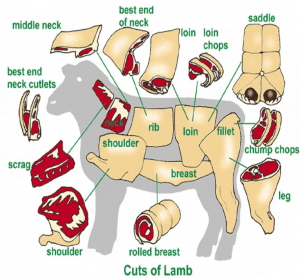SITHCCC014 – Prepare meat dishes
Due to the repetition of many of the elements in the core cookery units we have combined eight (8) units of competency into an 11 chapter learner guide. The units included in this volume are;
- SITHCCC005 – Prepare dishes using basic methods of cookery
- SITHCCC006 – Prepare appetisers and salads
- SITHCCC007 – Prepare stocks, sauces and soups
- SITHCCC008 – Prepare vegetable, fruit, egg and farinaceous dishes
- SITHCCC012 – Prepare poultry dishes
- SITHCCC013 – Prepare seafood dishes
- SITHCCC014 – Prepare meat dishes
- SITHCCC019 – Produce cakes, pastries and breads
Learning outcomes
In this chapter you will learn how to;
- Identify and select meat products and other ingredients from stores according to recipe, quality, freshness and stock rotation requirements.
- Thaw frozen meats safely
- Select and use meat cookery methods.
- Prepare marinades and meat accompaniments as required.
Introduction
Dishes prepared using meat products are among the most popular in todays restaurants and the way in which meat can be used and prepared varies greatly. This unit describes the performance outcomes, skills and knowledge required to prepare and cook a range of meat dishes following standard recipes. It requires the ability to select, prepare and portion meat, and to use relevant equipment and cookery methods.
Identify and select meat products and other ingredients
Meats for discussion in this manual include: lamb (hogget, mutton) and beef (veal) and pork. There are, of course, other meats include poultry and game, however, these meats are usually considered in a separate category from domesticated or farmed meats. It is important, in your role as a chef, to understand the various types of meat products available for you to work with and the cuts that these products can be sectioned in to.
Meat Cuts
- A carcase is a complete, dressed beast – that is minus head, hide, hooves and entrails.
- A side is a carcase, split along the backbone.
- A quarter is a side cut into two sections – forequarter (front part) and hindquarter (back part).
- Primary cuts are the first cuts after quartering a carcase. Bones and connective tissues are intact and individual muscles have not been separated. Secondary cuts or divided cuts are usually boned, trimmed, trussed or rolled and ready to portion or cook.
- Restaurant cuts are prepared, trimmed and shaped for immediate use. They can be purchased from a butcher but are usually prepared by kitchen staff.
Meat varieties
Sheep
Sheep can be purchased as young lamb, lamb, hogget or mutton.
- Lamb is the meat from the ovine (sheep) that is less than one year old. Young lamb is aged up to five months old, while lamb is up to 12 months old. It has a mild flavour and is low in internal and external fat. It requires short cooking times. The flesh will be a light red colour, fat should be white and firm and the meat should have a fine grain.
- Hogget is the meat from the ovine that s one to two years old. It has a more intense flavour than lamb, and is low to medium in internal and external fat. It requires longer cooking times than lamb and is suited to roasting, stewing and braising.
- Mutton is the meat from the ovine that is more than two years old. It has a very strong flavour, is high in internal and external fat. It requires extended cooking times and is more suited to curing, second class roasting (slow and low heat), stewing and braising. These cooking methods will render the excess fat and ensure the meat is tender.
Both hogget and mutton have a stronger flavour than lamb and the meats have a darker colour.
Dressed sheep meat can be purchased as:
- Carcase (whole dressed sheep or lamb)
- Side (whole carcase split along the length of the spinal column)
- Hindquarter
- Forequarter
- Individual cuts
The primal cuts from the forequarter of sheep or lamb is the loin and from the hindquarter is the long leg, mid loin/short loin, rib loin/rack and fillet/tenderloin (from the loin)
Secondary cuts include:
- Neck, square cut, shoulder, shank (from the forequarter)
- Short leg (leg chomp off) and chump (from the long leg)
Restaurant cuts might include:
- Cutlets, double cutlets and rack (from the rib loin)
- Rosettes and noisette (from the mid loin)
- Mignon (from the fillet
- Chump chops (from the chump)

….continued in learner guide….
For purchase information go back to hospitality unit page
